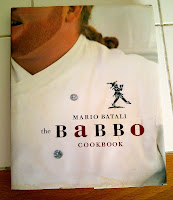Guest Post by Foodie PenPal, Kristina Scaviola
Food memories are powerful. My husband and I have built many memories around food, and perhaps one of the more pivotal moments happened when I was a freshman in college.
I decided I wanted to do something special for Mike as a Christmas present; we both watched the food channel, but as college students we were limited in our gastronomical adventures. Time, money, and lack of real kitchens kept most of our food exploration to limited restaurant experiences. So I sat in my wooden chair, in my tiny shared dorm room, wracking my brain. Mike’s favorite chef was Mario Batali, so I began by ordering the Babbo cookbook.

Unsatisfied, I went to the Babbo website to see just what type of commitment it would be to eat there. I began to read reviews that said that to secure a reservation that you had to call exactly one month prior to the date that you desired, and repeatedly dial until you could speak to a person. I picked a reasonable date over our Christmas break from college, sat down, and through my lunch hour from the moment the reservation line opened dialed again, and again, and again, until I secured our reservation: 6:15 p.m. on January 4th, 2003.
This was a revelatory dinner to say the least. A 7-course pasta tasting menu, at Babbo, at age 18. We ate many signature pastas: Angel’s pyramids, boar ragu, sweet breads- but perhaps the most memorable, due to color and our relative lack of dining experience was the squid ink tagliatelle with parsnip coins and pancetta: simple, startling in color, yet comforting flavor. This dish has been with us culinarily for many years.
It debuted at our very first dinner party, given in Mike’s college apartment in 2004. The reaction of our college friends to the deep black pasta with the caramelized parsnips, the porkiness of the pancetta, and a luxurious sprinkling of real Parmigiano was priceless.
The best part? The dish is incredibly simple to make. We spent much of 2003-2004 cooking through the Babbo cookbook- learning that a few simple ingredients, combined with care, can create an awesome experience. During this time we made our first Bolognese, duck ragu, homemade pasta, an intense lasagna (still an all-day production) and fed several people for several days with each experiment!
We now make our own squid ink pasta. Married, with a kitchen-aid and a pasta rolling attachment, a house and real kitchen, things are a little easier than the various college apartments we both lived in. What follows are my adaptations of Mario Batali’s recipes for both squid ink pasta and the accompanying parsnips and pancetta.
 Squid Ink Pasta
Squid Ink Pasta3 ½-4 cups of flour (or, ½ semolina and ½ flour- Semolina is slightly more difficult to work with, but very rewarding)
4 eggs
2 packets (or 2 tablespoons) of Squid Ink (
available on Amazon.com)
Method:On a large, clean work surface create a mound with the flour. In the center of the mound create a well for the eggs; crack the eggs into the center of the well. Add the squid ink, and with a fork break up the eggs as if you were preparing scrambled eggs. As you are breaking up the yokes, begin to draw in some of the flour from the sides of the well. You may have egg that runs over the side, volcano-style- this is OK, simply keep working in the flour. You will reach a point where the fork becomes pointless- this is when you switch to your clean (ring-less) hands. Do not try to work every last bit of flour in; the crunchy flour will not add anything to the texture of your pasta. When it forms dough, begin to knead the pasta. Batali’s recipe calls for 6 minutes of kneading; I find that there is a certain change that happens when the glutens have fully developed: the dough will be smooth and elastic, and almost have a snap to it. If you are unsure if it has been kneaded enough, kneed it some more. The pasta’s final texture is quite dependent on this step.
Allow the dough to rest, covered, for at least 30 minutes at room temperature. After resting, you can begin rolling the pasta. This is honestly easiest if you have a pasta rolling apparatus; but if you don’t, you can use a rolling pin and hand-roll all of the pasta. If you are choosing this method, I would recruit a partner, since your arms will be dead by the end! To do this, mimic the below method; folding the pasta over and progressively rolling it thinner and thinner.
Machine method:Cut the dough into usable chunks. Beginning on the largest setting, send a chunk of the dough through the machine several times, folding the pasta over on itself before putting it back through the machine (at least 6 passes at the thickest setting, maybe more depending on the texture- semolina dough often needs more passes). Bump the machine to the next setting, repeating the process.
Continue bumping one setting at a time, folding the pasta over with each pass. As the dough gets thinner, less passes through the machine become necessary; at setting 4 on my kitchen-aid the pasta usually only needs to go through 2-3x. Do not be discouraged by ripping or tearing; simply send the pasta through again. This is not pie dough where you are afraid to work it- the more the flour is worked, the more you develop the glutens. Repeat this process with the rest of your dough chunks.
At this point you can cut the pasta yourself, or send it through pasta cutters if you have them. Be ready with areas all over the kitchen for drying the pasta strands- we have a nice rack made of dowels that helps this; if you do not have a rack to dry the pasta on, paparadelle is a nice alternative to tagliatelle and requires less drying room!
Squid Ink Pasta with Parsnips and Pancetta (adapted from Mario Batali’s Babbo cookbook)
~serves 4 generously

- ¼ lb. Pancetta or slab bacon, cut into ½ inch cubes
- 1 tablespoon unsalted butter
- ½ lb. parsnips, cut thinly into half- moon shapes. (The original recipe calls for ½" thickness, but we have found that 1/8” - 1/4” works best.)
- Fresh cracked pepper
- ¼ cup flat leaf parsley, roughly cut or torn
- Parmigiano-Reggiano, or Pecorino Romano, for serving
- 1 lb. of fresh squid ink pasta, cut into tagliatelle (Dry squid ink pasta is available at gourmet food stores and Amazon.com and is a perfectly acceptable substitution! Cook the pasta according to package directions)
Method:1. Bring at least 6 quarts of heavily salted water to a boil.
2. In your largest sauté pan (at least 12-14 inches) cook the pancetta (or bacon) over relatively high heat until all of the fat has been rendered out and you have been left with browned, crisp cubes of pancetta. Remove the pancetta with a slotted spoon and place on a plate lined with a paper towel. Set aside.
3. Add the butter to the rendered fat; when it has melted add the parsnips to the pan. Over moderately high heat, and without shaking or stirring the pan, caramelize the parsnips in the fat. If you stir and shake the pan too much the parsnips will cook, but the sugars will not form the all-important crusty caramel layer that is vital to this dish. The recipe says this takes 5-6 minutes; I have found it can take double this time due to a lack of copper core pans and BTUs on our stove!
4. Cook the tagliatelle in the boiling water until al dente. Reserve some of the cooking water (I usually pull out about a cup just before draining the pasta). Fresh pasta only takes 2 or so minutes; be ready with a spider or fork to fish the pasta out of the water, or drain the pasta into a large colander in the sink.
5. Add the hot pasta directly to the sauté pan, and toss the hot pasta with the parsnips over high heat. Add the pancetta back to the pan, and toss some more. If the pasta appears too dry, add a little of the pasta cooking liquid at a time.
6. Taste a little of the pasta; season with a little salt (keeping in mind that you will be adding salty cheese, so do not overdo it), and course fresh cracked pepper.
7. Divide among 4 bowls or plates, topping with freshly grated cheese and parsley.
8. Enjoy!
Wine recommendation: This is a bacon-y dish, with some sweetness from the parsnips- I find that it pairs very well with a white wine that is slightly off-dry such as a Viognier or Pouilly-Fuisse. Look for a wine with decent minerality and a muscat nose for the full effect!
 Earlier in this month, I learned that I would be mailing goodies to Tenecia (of Boobs, Barbells, and Broccoli fame) while somewhere in the foodie universe someone had gotten my name. I couldn’t wait to go shopping! Then a day after I sent my box, one arrived in the mail addressed to me.
Earlier in this month, I learned that I would be mailing goodies to Tenecia (of Boobs, Barbells, and Broccoli fame) while somewhere in the foodie universe someone had gotten my name. I couldn’t wait to go shopping! Then a day after I sent my box, one arrived in the mail addressed to me. One example of the Old Bay flavors in use is the crab chips that I included in my penpal package. UTZ chips have been made in nearby Hanover, Pennsylvania since 1921 and sold in Baltimore since the beginning. UTZ chips are so pervasive in Baltimore that a local jeweler used the UTZ girl image in a really cute advertising campaign. She is being proposed to by the Natty Boh’ man, the other favorite local logo. The tagline reads, “Where Baltimore gets engaged.”
One example of the Old Bay flavors in use is the crab chips that I included in my penpal package. UTZ chips have been made in nearby Hanover, Pennsylvania since 1921 and sold in Baltimore since the beginning. UTZ chips are so pervasive in Baltimore that a local jeweler used the UTZ girl image in a really cute advertising campaign. She is being proposed to by the Natty Boh’ man, the other favorite local logo. The tagline reads, “Where Baltimore gets engaged.” 











